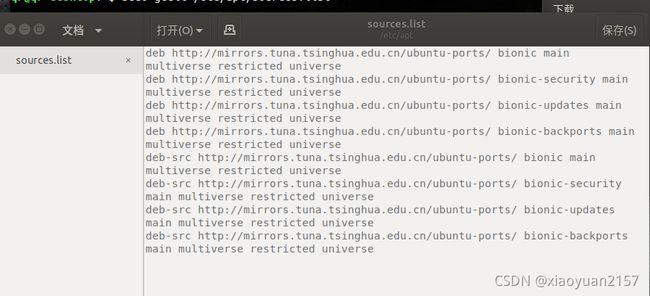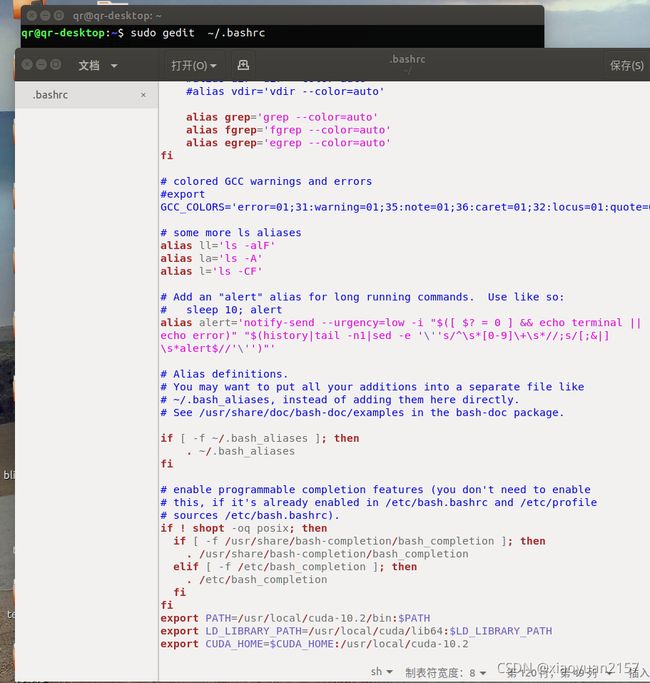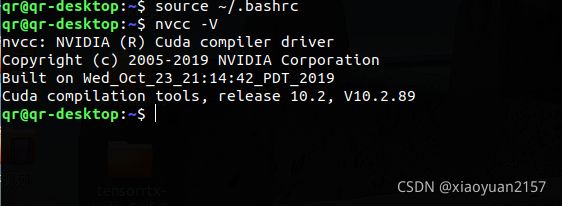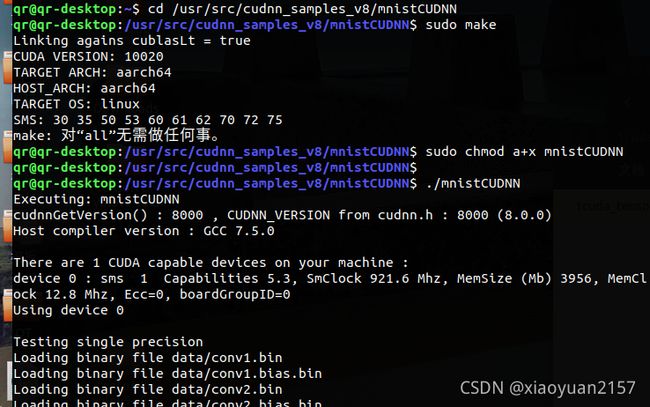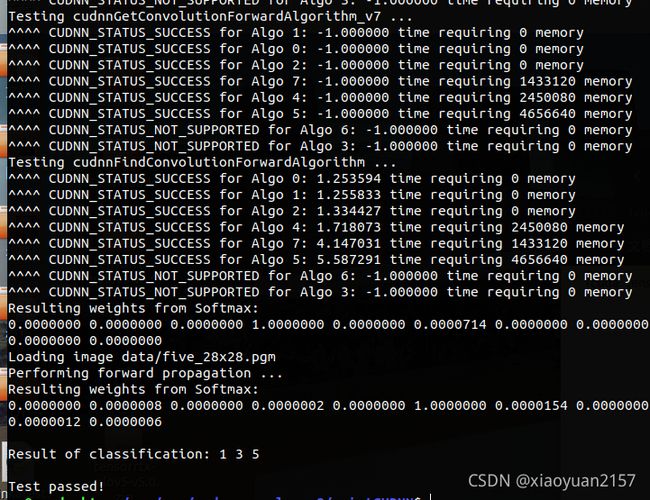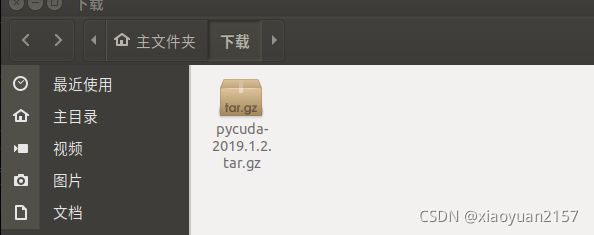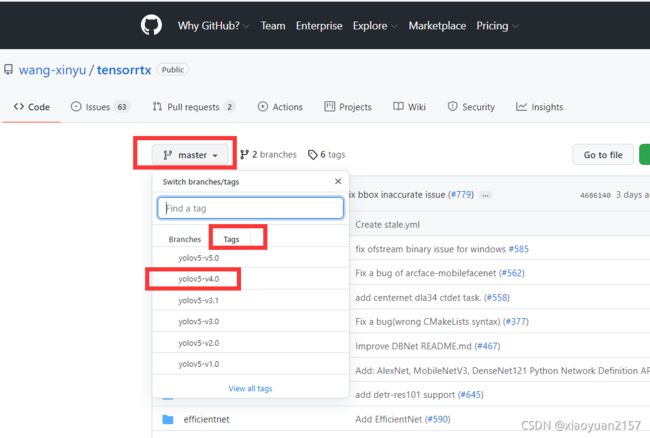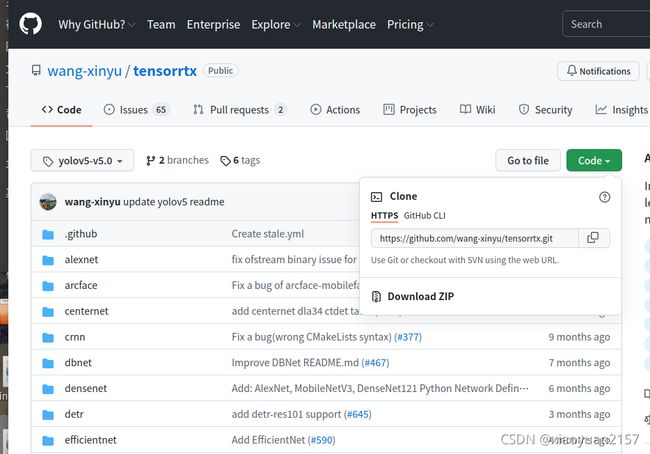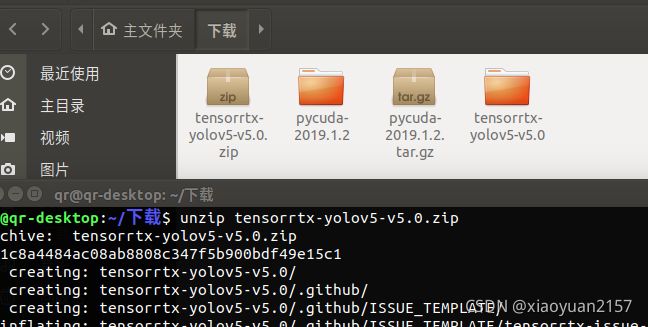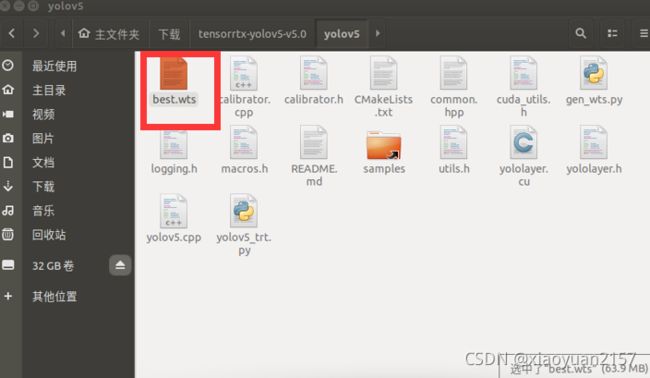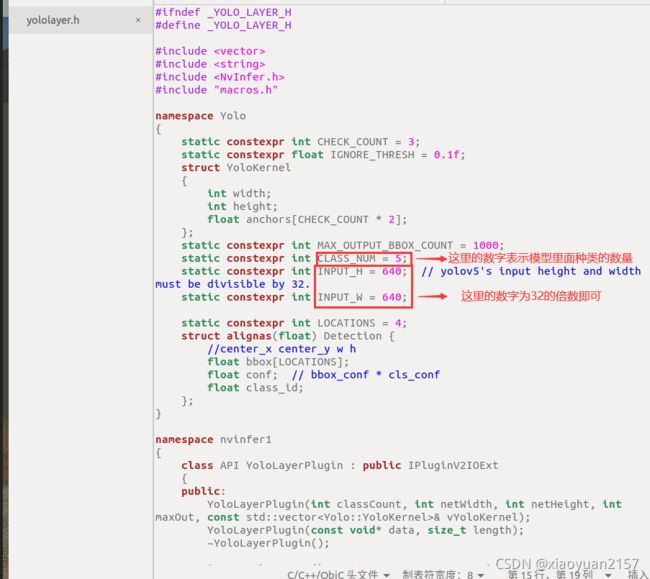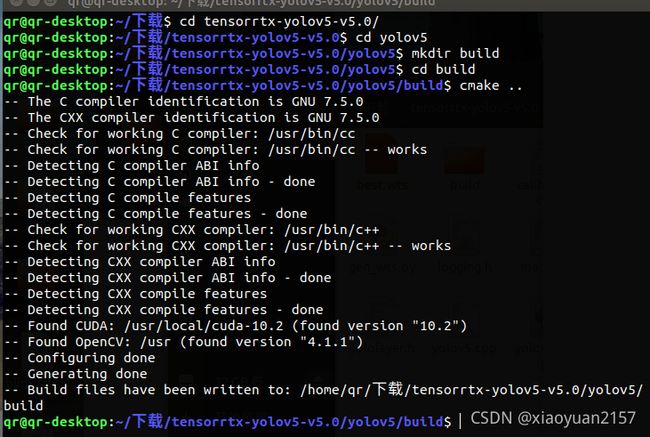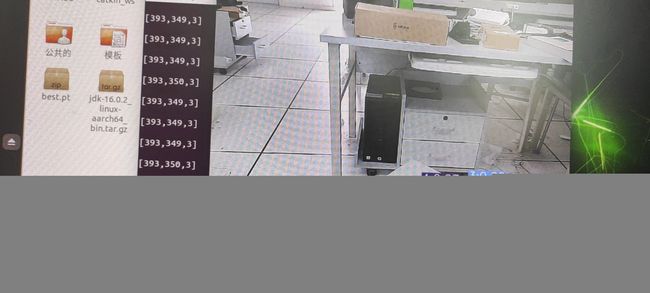Yolov5学习笔记(2)——部署在jetson nano上
本教程系列将从模型训练开始,从0开始带领你部署Yolov5模型到jetson nano上
这是本系列的第二部分内容
目录
1.更换源
2.更改环境变量
2.2测试CUDA
2.3安装pip3
2 .4安装GPU版的tensorflow
2.5安装pycuda
3.1下载tensorrtx的源码
3.2模型测试
1.更换源
Ubuntu跟Windows不同,能从官方指定的源服务器上下载安装各种软件,不用满世界找,但是默认的源可能在国外,速度很慢,有
的包无法安装。所谓换源就是更改源服务器,一般换成国内的。
简单通俗点来说就是,如果你希望加快下载各种包的速度要做的事情
我用的一般都是清华源,也有用中科大的源
先备份本身的源,防止误操作后无法删除
这里没有用vim,gedit更加方便
sudo cp /etc/apt/sources.list /etc/apt/sources.list.bak #为防止误操作后无法恢复,先备份原文件sources.list
sudo gedit /etc/apt/sources.list 然后删除所有内容,复制以下内容,保存
deb http://mirrors.tuna.tsinghua.edu.cn/ubuntu-ports/ bionic main multiverse restricted universe
deb http://mirrors.tuna.tsinghua.edu.cn/ubuntu-ports/ bionic-security main multiverse restricted universe
deb http://mirrors.tuna.tsinghua.edu.cn/ubuntu-ports/ bionic-updates main multiverse restricted universe
deb http://mirrors.tuna.tsinghua.edu.cn/ubuntu-ports/ bionic-backports main multiverse restricted universe
deb-src http://mirrors.tuna.tsinghua.edu.cn/ubuntu-ports/ bionic main multiverse restricted universe
deb-src http://mirrors.tuna.tsinghua.edu.cn/ubuntu-ports/ bionic-security main multiverse restricted universe
deb-src http://mirrors.tuna.tsinghua.edu.cn/ubuntu-ports/ bionic-updates main multiverse restricted universe
deb-src http://mirrors.tuna.tsinghua.edu.cn/ubuntu-ports/ bionic-backports main multiverse restricted universe别忘记更新一下哦
sudo apt-get update2.更改环境变量
在更改环境变量之前,记得确定好cuda的版本,在添加环境变量的时候,因为cuda的版本原因导致的错误很常见,输入下面路径查看cuda版本
cd /usr/local
ls如上图所示,cuda版本为10.2,那么路径也为cuda-10.2现在就可以添加环境变量了
sudo gedit ~/.bashrc在文本的最后添加以下三行:
export PATH=/usr/local/cuda-10.2/bin:$PATH
export LD_LIBRARY_PATH=/usr/local/cuda/lib64:$LD_LIBRARY_PATH
export CUDA_HOME=$CUDA_HOME:/usr/local/cuda-10.2重新执行.bashrc文件,可以直接生效;
source ~/.bashrc输入nvcc -V命令测试环境变量是否正确
nvcc -V2.2测试CUDA
依次输入下面的命令测试cuda
cd /usr/src/cudnn_samples_v8/mnistCUDNN
sudo make
sudo chmod a+x mnistCUDNN
./mnistCUDNN等待片刻后,出现test passed表明成功(如下图)
2.3安装pip3
可能有同学要问了,pip是个啥,其实这不重要,你可以把他当作一个下载器,pip是Python 的包管理器,python已经来到了3.0版本,如果用pip的话,下载下来的包会保存在python2.7版本的路径下,总之,最后用pip3来下载安装python的各类包,避免后期出现麻烦
sudo apt-get install python3-pip python3-dev如果在使用的过程中出现报不能导入’main’错误
打开路径 "/usr/bin/"下的pip3文件,
将内容
from pip import main
if __name__ == '__main__':
sys.exit(main())
修改为
from pip import __main__
if __name__ == '__main__':
sys.exit(__main__._main())2 .4安装GPU版的tensorflow
首先得安装一些依赖
sudo apt-get install libhdf5-serial-dev hdf5-tools安装GPU版本的tensorflow
pip3 install --extra-index-url https://developer.download.nvidia.com/compute/redist/jp/v42 tensorflow-gpu==1.13.1+nv19.3 --user如果说你对自己安装的tensorflow版本不太放心,或者在下载过程中网络断开的话,不妨用下面的代码测试一下
import tensorflow as tf
with tf.device('/cpu:0'):
a = tf.constant([1.0,2.0,3.0],shape=[3],name='a')
b = tf.constant([1.0,2.0,3.0],shape=[3],name='b')
with tf.device('/gpu:1'):
c = a+b
sess = tf.Session(config=tf.ConfigProto(allow_soft_placement=True,log_device_placement=True))
sess.run(tf.global_variables_initializer())
print(sess.run(c))
安装一些机器学习常用的库
sudo apt-get install python3-numpy
sudo apt-get install python3-scipy
sudo apt-get install python3-pandas
sudo apt-get install python3-matplotlib
sudo apt-get install python3-sklearn
2.5安装pycuda
pycuda-2019.1.2点击下载pycuda2019版本pycuda-2019.1.2 这里有pycuda的github源码,里面有各种pycuda版本,但是可能会出现一些版本不兼容的问题
https://github.com/inducer/pycuda
下载完成后来到下载好的路径下,终端打开,依次输入下解压安装
tar zxvf pycuda-2019.1.2.tar.gz
cd pycuda-2019.1.2/
python3 configure.py --cuda-root=/usr/local/cuda-10.2
sudo python3 setup.py install安装过程中出现类似下图中的内容可以暂时忽略
稍作等待几分钟,直到出现安装完成
3.1下载tensorrtx的源码
很高兴你能来到这里,到这里已经完成了一半,是不是觉得很麻烦,别担心,当你完成了部署结果一定会让你很兴奋的
进入tensorrtx的官网,下载你训练时对应的yolov5的版本,点击左上角的master-->tags-->yolov5
如:yolov5-4.0版本的模型,要下载yolo5版本的tensorrtx进行部署,否则在生成引擎文件时会出现报错
点击右边绿色的Code,然后Download ZIP
下载完成后,来到下载目录下,输入以下命令解压,我这里是v5.0版本
unzip tensorrtx-yolov5-v5.0.zip把之前训练的模型生成的wts权重文件放到tensorrtx的yolov5文件夹中
没有wts文件只是想体验强大的jetson nano的同学可以先下载一下我的五类垃圾分类权重文件
链接: https://pan.baidu.com/s/1nciB7Xn1vXj9ZfBAoj39Bw 提取码: r74h
来到tensorrtx的yolov5文件夹,打开yololayer.h的代码,修改CLASS_NUM
创建进入文件夹build并cmake ..
mkdir build
cd build
cmake ..make -j6生成引擎文件
sudo ./yolov5 -s ../best.wts best.engine s 这一段模型引擎生成的命令解释如下
sudo ./yolov5 -s/ [.wts文件路径] [.engine文件名称] [s/m/l/x/s6/m6/l6/x6 or c/c6 gd gw]
稍作等待后,出现Build engine successfully!表示生成完成,这时build文件夹里面会多出一个best.engine文件
3.2模型测试
到这里,恭喜你已经完成了模型的部署,我们放自己根据官方的yolov5_trt改的代码来测试一下
是不是很棒!
"""
# Yolov5 基于pytorch,修改起来更加方便快捷;
# yolov5自带anchor生成器,自动为你的数据集生成最优化的anchor;
# yolov5的整体AP比yolov4更高。
"""
import ctypes
import os
import random
import sys
import threading
import time
# 安装串口函数库 sudo pip3 install pyserial
import serial as ser # 导入串口库
import cv2
import numpy as np # 构造ndarray对象
import pycuda.autoinit
import pycuda.driver as cuda
import tensorrt as trt
from time import sleep
# from jetcam.csi_camera import CSICamera
# import torch
# import torchvision#在nano上安装这两个库是有些麻烦的特别是torchvision。
INPUT_W = 640
INPUT_H = 640
CONF_THRESH = 0.8 # 概率阈值
IOU_THRESHOLD = 0.1
# 定义画框函数
def plot_one_box(x, img, color=None, label=None, line_thickness=None):
'''
description: Plots one bounding box on image img,
this function comes from YoLov5 project.
param:
x: a box likes [x1,y1,x2,y2]
img: a opencv image object
label: str
line_thickness: int
return:
no return
'''
# img, result_boxes, result_scores, result_classid = yolov5_wrapper.infer(img)
# img = draw_boxes(img, result_boxes, result_scores, result_classid)
tl = (
line_thickness or round(0.002 * (img.shape[0] + img.shape[1]) / 2) + 1
) # line/font thickness
color = color or [random.randint(0, 255) for _ in range(3)]
c1, c2 = (int(x[0]), int(x[1])), (int(x[2]), int(x[3]))
cv2.rectangle(img, c1, c2, color, thickness=tl, lineType=cv2.LINE_AA)
# print("left:(" + str(c1[0]) + "," + str(c1[1]) +")","right:(" + str(c2[0]) + "," + str(c2[1])+ ")")
a = int(c1[0])
b = int(c2[0])
c = int(c1[1])
d = int(c2[1])
x1 = (b + a) / 2
x = int(x1)
y1 = (d + c) / 2
y = int(y1)
r = label[2:6] #rate
sleep(0.0009)
c =str(label[0]) #class
# print(c)
# if(c == 0):
# r0 = label[2:6]
# elif(c == 1):
# r1 = label[2:6]
# elif(c == 2):
# r2 = label[2:6]
# elif(c == 3):
# r3 = label[2:6]
# elif(c == 4):
# r4 = label[2:6]
# # output_str = ('[' + str(x) + ',' + str(y) + ',' +str(c) + ']'+'\r\n')
# if(c == 3 or r3>r0 or r3>r2 or r3>r1 or r3>r4):
# print('[' + str(x) + ',' + str(y) + ',' +str(3) + ']'+'\r\n')
# else:
# print(r)
# print(x,y)
#se.write(str(label))
#print(label[0])
#print(r)#label rate
#se.write((int(x) + ',' + int(y) + ',' +int(label[0]) + '\r\n').encode())
# output_str = ('[' + str(x) + ',' + str(y) + ',' +str(label[0]) + ']'+'\r\n')
# print(output_str)
# print(r)
# se.write(output_str.encode())
# sleep(0.0009)
# se.write((x + y + '\r\n').encode())
if label:
tf = max(tl - 1, 1) # font thickness
t_size = cv2.getTextSize(label, 0, fontScale=tl / 3, thickness=tf)[0]
c2 = c1[0] + t_size[0], c1[1] - t_size[1] - 3
cv2.rectangle(img, c1, c2, color, -1, cv2.LINE_AA) # filled
cv2.putText(
img,
label,
(c1[0], c1[1] - 2),
0,
tl / 3,
[225, 255, 255],
thickness=tf,
lineType=cv2.LINE_AA,
)
return x, y
# 画框函数
def draw_boxes(image_raw, result_boxes, result_scores, result_classid):
max_scores = -1
max_index = -1
max_x,max_y = -1,-1
for i in range(len(result_boxes)):
box = result_boxes[i]
x, y = plot_one_box(
box,
image_raw,
label="{}:{:.2f}".format(
categories[int(result_classid[i])], result_scores[i]
)
)
# print(result_classid[i])
# se.write((str(x) + ',' + str(y) + ',' + str(result_classid[i]) + '\r\n').encode())
# global max_score
if result_boxes.all() > max_scores:
max_scores = result_scores[i]
max_index = i
max_x, max_y = x, y
if max_scores != -1:
c = int(result_classid[max_index])
output_str = ('[' + str(x) + ',' + str(y) + ',' +str(c) + ']'+'\r\n')
print(output_str)
se.write(output_str.encode())
sleep(0.0009)
return image_raw
# yolov5模型转到TensorRT中推理
# 定义yolov5转trt的类 start
class YoLov5TRT(object):
"""
description: A YOLOv5 class that warps TensorRT ops, preprocess and postprocess ops.
"""
def __init__(self, engine_file_path):
# Create a Context on this device,
self.ctx = cuda.Device(0).make_context()
stream = cuda.Stream()
TRT_LOGGER = trt.Logger(trt.Logger.INFO)
runtime = trt.Runtime(TRT_LOGGER)
# Deserialize the engine from file
with open(engine_file_path, "rb") as f:
engine = runtime.deserialize_cuda_engine(f.read())
context = engine.create_execution_context()
host_inputs = []
cuda_inputs = []
host_outputs = []
cuda_outputs = []
bindings = []
for binding in engine:
size = trt.volume(engine.get_binding_shape(binding)) * engine.max_batch_size
dtype = trt.nptype(engine.get_binding_dtype(binding))
# Allocate host and device buffers
host_mem = cuda.pagelocked_empty(size, dtype)
cuda_mem = cuda.mem_alloc(host_mem.nbytes)
# Append the device buffer to device bindings.
bindings.append(int(cuda_mem))
# Append to the appropriate list.
if engine.binding_is_input(binding):
host_inputs.append(host_mem)
cuda_inputs.append(cuda_mem)
else:
host_outputs.append(host_mem)
cuda_outputs.append(cuda_mem)
# Store
self.stream = stream
self.context = context
self.engine = engine
self.host_inputs = host_inputs
self.cuda_inputs = cuda_inputs
self.host_outputs = host_outputs
self.cuda_outputs = cuda_outputs
self.bindings = bindings
# 释放引擎,释放GPU显存,释放CUDA流
def __del__(self):
print("delete object to release memory")
def infer(self, input_image_path):
threading.Thread.__init__(self)
# Make self the active context, pushing it on top of the context stack.
self.ctx.push()
# Restore
stream = self.stream
context = self.context
engine = self.engine
host_inputs = self.host_inputs
cuda_inputs = self.cuda_inputs
host_outputs = self.host_outputs
cuda_outputs = self.cuda_outputs
bindings = self.bindings
# Do image preprocess
input_image, image_raw, origin_h, origin_w = self.preprocess_image(
input_image_path
)
# Copy input image to host buffer
np.copyto(host_inputs[0], input_image.ravel())
start = time.time()
# Transfer input data to the GPU.
cuda.memcpy_htod_async(cuda_inputs[0], host_inputs[0], stream)
# Run inference.
context.execute_async(bindings=bindings, stream_handle=stream.handle)
# Transfer predictions back from the GPU.
cuda.memcpy_dtoh_async(host_outputs[0], cuda_outputs[0], stream)
# Synchronize the stream
stream.synchronize()
end = time.time()
# Remove any context from the top of the context stack, deactivating it.
self.ctx.pop()
# Here we use the first row of output in that batch_size = 1
output = host_outputs[0]
# Do postprocess
result_boxes, result_scores, result_classid = self.post_process(
output, origin_h, origin_w
)
# Draw rectangles and labels on the original image
# for i in range(len(result_boxes)):
# box = result_boxes[i]
# plot_one_box(
# box,
# image_raw,
# label="{}:{:.2f}".format(
# categories[int(result_classid[i])], result_scores[i]
# ),
# )
# parent, filename = os.path.split(input_image_path)
# save_name = os.path.join(parent, "output_" + filename)
## Save image
# cv2.imwrite(save_name, image_raw)
# print('{:.2f}ms, saving {}'.format((end - start) * 1000, save_name))
return image_raw, result_boxes, result_scores, result_classid
def destroy(self):
# Remove any context from the top of the context stack, deactivating it.
self.ctx.pop()
def preprocess_image(self, image_raw):
"""
description: Read an image from image path, convert it to RGB,
resize and pad it to target size, normalize to [0,1],
transform to NCHW format.
param:
input_image_path: str, image path
return:
image: the processed image
image_raw: the original image
h: original height
w: original width
"""
h, w, c = image_raw.shape
image = cv2.cvtColor(image_raw, cv2.COLOR_BGR2RGB)
# Calculate widht and height and paddings
r_w = INPUT_W / w
r_h = INPUT_H / h
if r_h > r_w:
tw = INPUT_W
th = int(r_w * h)
tx1 = tx2 = 0
ty1 = int((INPUT_H - th) / 2)
ty2 = INPUT_H - th - ty1
else:
tw = int(r_h * w)
th = INPUT_H
tx1 = int((INPUT_W - tw) / 2)
tx2 = INPUT_W - tw - tx1
ty1 = ty2 = 0
# Resize the image with long side while maintaining ratio
image = cv2.resize(image, (tw, th))
# Pad the short side with (128,128,128)
image = cv2.copyMakeBorder(
image, ty1, ty2, tx1, tx2, cv2.BORDER_CONSTANT, (128, 128, 128)
)
image = image.astype(np.float32)
# Normalize to [0,1]
image /= 255.0
# HWC to CHW format:
image = np.transpose(image, [2, 0, 1])
# CHW to NCHW format
image = np.expand_dims(image, axis=0)
# Convert the image to row-major order, also known as "C order":
image = np.ascontiguousarray(image)
return image, image_raw, h, w
def xywh2xyxy(self, origin_h, origin_w, x):
"""
description: Convert nx4 boxes from [x, y, w, h] to [x1, y1, x2, y2] where xy1=top-left, xy2=bottom-right
param:
origin_h: height of original image
origin_w: width of original image
x: A boxes tensor, each row is a box [center_x, center_y, w, h]
return:
y: A boxes tensor, each row is a box [x1, y1, x2, y2]
"""
y = np.zeros_like(x)
# y = torch.zeros_like(x) if isinstance(x, torch.Tensor) else np.zeros_like(x)
r_w = INPUT_W / origin_w
r_h = INPUT_H / origin_h
if r_h > r_w:
y[:, 0] = x[:, 0] - x[:, 2] / 2
y[:, 2] = x[:, 0] + x[:, 2] / 2
y[:, 1] = x[:, 1] - x[:, 3] / 2 - (INPUT_H - r_w * origin_h) / 2
y[:, 3] = x[:, 1] + x[:, 3] / 2 - (INPUT_H - r_w * origin_h) / 2
y /= r_w
else:
y[:, 0] = x[:, 0] - x[:, 2] / 2 - (INPUT_W - r_h * origin_w) / 2
y[:, 2] = x[:, 0] + x[:, 2] / 2 - (INPUT_W - r_h * origin_w) / 2
y[:, 1] = x[:, 1] - x[:, 3] / 2
y[:, 3] = x[:, 1] + x[:, 3] / 2
y /= r_h
return y
# 往YoLov5TRT这个类中加入一个方法,此处是用numpy的方式实现nms
def nms(self, boxes, scores, iou_threshold=IOU_THRESHOLD): # 非极大值抑制,是目标检测框架中的后处理模块
# 空间距离结合并交比(IOU)完成聚类划分
x1 = boxes[:, 0]
y1 = boxes[:, 1]
x2 = boxes[:, 2]
y2 = boxes[:, 3]
areas = (y2 - y1 + 1) * (x2 - x1 + 1)
scores = scores
keep = []
index = scores.argsort()[::-1]
while index.size > 0:
i = index[0] # every time the first is the biggst, and add it directly
keep.append(i)
x11 = np.maximum(x1[i], x1[index[1:]]) # calculate the points of overlap
y11 = np.maximum(y1[i], y1[index[1:]])
x22 = np.minimum(x2[i], x2[index[1:]])
y22 = np.minimum(y2[i], y2[index[1:]])
w = np.maximum(0, x22 - x11 + 1) # the weights of overlap
h = np.maximum(0, y22 - y11 + 1) # the height of overlap
overlaps = w * h
ious = overlaps / (areas[i] + areas[index[1:]] - overlaps)
idx = np.where(ious <= iou_threshold)[0]
index = index[idx + 1] # because index start from 1
# print(overlaps)
# print(x1)
# sleep(1)
return keep
# 把nms的结果赋值给indices变量,改写post_process函数
def post_process(self, output, origin_h, origin_w):
"""
description: postprocess the prediction
param:
output: A tensor likes [num_boxes,cx,cy,w,h,conf,cls_id, cx,cy,w,h,conf,cls_id, ...]
origin_h: height of original image
origin_w: width of original image
return:
result_boxes: finally boxes, a boxes tensor, each row is a box [x1, y1, x2, y2]
result_scores: finally scores, a tensor, each element is the score correspoing to box
result_classid: finally classid, a tensor, each element is the classid correspoing to box
"""
# Get the num of boxes detected
num = int(output[0])
# Reshape to a two dimentional ndarray
pred = np.reshape(output[1:], (-1, 6))[:num, :]
# to a torch Tensor
# pred = torch.Tensor(pred).cuda()#去掉这行,用torchvision库中的nms方法来完成非极大值抑制。
# Get the boxes
boxes = pred[:, :4]
# Get the scores
scores = pred[:, 4]
# Get the classid
classid = pred[:, 5]
# Choose those boxes that score > CONF_THRESH
si = scores > CONF_THRESH
boxes = boxes[si, :]
scores = scores[si]
classid = classid[si]
# Trandform bbox from [center_x, center_y, w, h] to [x1, y1, x2, y2]
boxes = self.xywh2xyxy(origin_h, origin_w, boxes)
# Do nms
# 去掉cpu方法,因为ndarray没有这个方法
# indices = torchvision.ops.nms(boxes, scores, iou_threshold=IOU_THRESHOLD).cpu()
# result_boxes = boxes[indices, :].cpu()
# result_scores = scores[indices].cpu()
# result_classid = classid[indices].cpu()
indices = self.nms(boxes, scores, IOU_THRESHOLD)
result_boxes = boxes[indices, :]
result_scores = scores[indices]
result_classid = classid[indices]
# print(result_boxes)
# print(result_classid)
return result_boxes, result_scores, result_classid
class myThread(threading.Thread):
def __init__(self, func, args):
threading.Thread.__init__(self)
self.func = func
self.args = args
def run(self):
self.func(*self.args)
# 摄像头检测
def detect_camera(camera, yolov5_wrapper):
# def detect_camera(x,camera, yolov5_wrapper):
count = 0
# c1, c2 = (int(x[0]), int(x[1])), (int(x[2]), int(x[3]))
# cv2.rectangle(img, c1, c2, color, thickness=tl, lineType=cv2.LINE_AA)
# print("left:(" + str(c1[0]) + "," + str(c1[1]) +")","right:(" + str(c2[0]) + "," + str(c2[1])+ ")")
# x = str(c1[0])
# y = str(c1[1])
# print(x)
# 开始循环检测
while True:
# img = camera.read()#CSI摄像头
ret, img = camera.read() # usb摄像头用这个
img, result_boxes, result_scores, result_classid = yolov5_wrapper.infer(img)
img = draw_boxes(img, result_boxes, result_scores, result_classid)
count = count + 1
cv2.imshow("result", img) # 显示结果
if cv2.waitKey(1) == ord('q'):
break
# 定义摄像头函数
def main_camera():
camera = cv2.VideoCapture(0) # usb摄像头用这个
# camera = CSICamera(capture_device=0, width=640, height=480)
# load custom plugins
camera.set(3, 640)
camera.set(4, 480)
PLUGIN_LIBRARY = "build/libmyplugins.so"
ctypes.CDLL(PLUGIN_LIBRARY)
engine_file_path = "build/yolov5s.engine"
# YoLov5TRT instance
yolov5_wrapper = YoLov5TRT(engine_file_path)
print("start detection!")
detect_camera(camera, yolov5_wrapper)
# camera.release() # 使用cv方法打开摄像头才需要这句
cv2.destroyAllWindows()
print("\nfinish!")
if __name__ == "__main__":
# load custom plugins 修改成你build出来的引擎的相对路径
PLUGIN_LIBRARY = "build/libmyplugins.so"
ctypes.CDLL(PLUGIN_LIBRARY)
engine_file_path = "build/yolov5s.engine"
se = ser.Serial('/dev/ttyTHS1', 115200, timeout=0.5) # 设置使用的引脚、波特率和超时时间 8接R,10接T
# load coco labels
# categories = ['battery', 'orange', 'bottle', 'paper_cup', 'spitball'] # 垃圾种类
categories = ['0', '1', '2', '3', '4'] # 垃圾种类
# a YoLov5TRT instance
# yolov5_wrapper = YoLov5TRT(engine_file_path)
# input_image_paths = ["samples/zidane.jpg", "samples/bus.jpg"]
# for input_image_path in input_image_paths:
# # create a new thread to do inference
# thread1 = myThread(yolov5_wrapper.infer, [input_image_path])
# thread1.start()
# thread1.join()
#writen by lyj
## destroy the instance
# yolov5_wrapper.destroy()
main_camera()
#context.pop()
参考文章
jetson nano安装pycuda!!!_帅的发光发亮的博客-CSDN博客_jetson nano安装pycuda
(26条消息) Jetson Nano配置与使用(5)cuda测试及tensorflow gpu安装_u013617229的博客-CSDN博客
